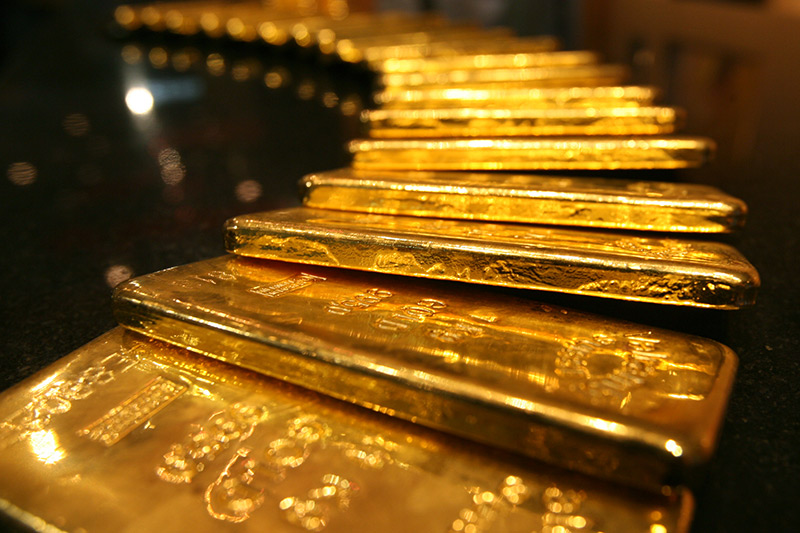Investing.com - Gold futures edged lower on Wednesday, easing off a two-and-a-half-week high as the U.S. dollar strengthened after disappointing euro zone manufacturing data, while concerns over Greece’s financial woes persisted.
On the Comex division of the New York Mercantile Exchange, gold futures for April delivery traded at USD1,755.75 a troy ounce during early U.S. morning trade, easing down 0.16%.
It earlier fell by as much as 0.55% to trade at a session low USD1,750.85 a troy ounce.
Futures were likely to find support at USD1,732.35 a troy ounce, Tuesday’s low and short-term resistance at USD1,765.85, the high from February 3.
Gold’s losses came as the dollar index, which tracks the performance of the greenback versus a basket of six other major currencies, rose 0.26% to trade at 79.38.
A stronger U.S. dollar usually weighs on gold, as it dampens the metal's appeal as an alternative asset and makes dollar-priced commodities more expensive for holders of other currencies.
Preliminary data released earlier showed that manufacturing activity in the euro zone improved less-than-expected in February, remaining in contraction territory for the seventh consecutive month.
Data from Germany and France showed modest growth in business activity, albeit at a slower pace than in January, but activity in peripheral euro zone nation’s showed a steep decline this month.
Markets were also jittery after Fitch Ratings cut Greece’s credit rating to C from CCC and reiterated that a bond-swap agreement with private creditors would be a restricted default.
Fitch said it would review its stance on Greece again once the debt swap had been completed.
The downgrade comes after euro zone finance ministers approved a second bailout package for the debt-laden country, adding to uncertainty over Greece’s ability to implement strict austerity measures in compliance with its new bailout deal.
Some profit taking also weighed after gold futures posted their biggest one-day gain in nearly two weeks on Tuesday, rallying 1.5% to the highest level since early February.
While gold is traditionally viewed as a safe haven, the metal has been tracking riskier assets in the past few months as the turmoil caused by the euro zone debt crisis forces investors to sell their profitable gold positions to cover losses elsewhere.
Wednesday’s trading was characterized by a lack of conviction as the absence of positive catalysts pushed many investors to the sidelines.
Barclays said in a report Tuesday that “gold is searching for its next catalyst” after trading in a range between USD1,700 and USD1,760 since the beginning of February.
Some market participants believe the European Central Bank’s second liquidity injection operation next week will be a positive catalyst, while others said growing tension between Iran and the West was likely to propel prices higher.
Elsewhere on the Comex, silver for March delivery tumbled 1.35% to trade at USD33.96 a troy ounce, while copper for March delivery dropped 0.9% to trade at USD3.802 a pound.
On the Comex division of the New York Mercantile Exchange, gold futures for April delivery traded at USD1,755.75 a troy ounce during early U.S. morning trade, easing down 0.16%.
It earlier fell by as much as 0.55% to trade at a session low USD1,750.85 a troy ounce.
Futures were likely to find support at USD1,732.35 a troy ounce, Tuesday’s low and short-term resistance at USD1,765.85, the high from February 3.
Gold’s losses came as the dollar index, which tracks the performance of the greenback versus a basket of six other major currencies, rose 0.26% to trade at 79.38.
A stronger U.S. dollar usually weighs on gold, as it dampens the metal's appeal as an alternative asset and makes dollar-priced commodities more expensive for holders of other currencies.
Preliminary data released earlier showed that manufacturing activity in the euro zone improved less-than-expected in February, remaining in contraction territory for the seventh consecutive month.
Data from Germany and France showed modest growth in business activity, albeit at a slower pace than in January, but activity in peripheral euro zone nation’s showed a steep decline this month.
Markets were also jittery after Fitch Ratings cut Greece’s credit rating to C from CCC and reiterated that a bond-swap agreement with private creditors would be a restricted default.
Fitch said it would review its stance on Greece again once the debt swap had been completed.
The downgrade comes after euro zone finance ministers approved a second bailout package for the debt-laden country, adding to uncertainty over Greece’s ability to implement strict austerity measures in compliance with its new bailout deal.
Some profit taking also weighed after gold futures posted their biggest one-day gain in nearly two weeks on Tuesday, rallying 1.5% to the highest level since early February.
While gold is traditionally viewed as a safe haven, the metal has been tracking riskier assets in the past few months as the turmoil caused by the euro zone debt crisis forces investors to sell their profitable gold positions to cover losses elsewhere.
Wednesday’s trading was characterized by a lack of conviction as the absence of positive catalysts pushed many investors to the sidelines.
Barclays said in a report Tuesday that “gold is searching for its next catalyst” after trading in a range between USD1,700 and USD1,760 since the beginning of February.
Some market participants believe the European Central Bank’s second liquidity injection operation next week will be a positive catalyst, while others said growing tension between Iran and the West was likely to propel prices higher.
Elsewhere on the Comex, silver for March delivery tumbled 1.35% to trade at USD33.96 a troy ounce, while copper for March delivery dropped 0.9% to trade at USD3.802 a pound.
